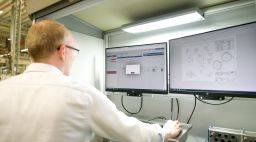How to stay competitive
“In the automotive industry, competitiveness is one of the biggest challenges,” explains Tim Polleunis, Plant Manager at VCST. "We explored ways to improve and stay competitive. Ultimately, we decided to invest in digitalization. We aimed to digitize and connect processes that were once done with pen and paper to enhance efficiency and productivity.
In the past, it took a lot of time because everything was recorded with pen and paper, which made it difficult for the company to analyze its operations. Thanks to the digitalization process, all data within production, quality, maintenance, and logistics is now automatically recorded. "Although the processes are now faster and more efficient, we remain committed to further improving efficiency," adds Tim Polleunis.
In the past, many tasks were done on paper, increasing the likelihood of human errors and the risk of losing documentation.
In the automotive industry, strong competition is one of the biggest challenges.
Previously, product information was scattered across different locations.
Tim Polleunis
Plant Manager at VCST

A single place for all product information
"We were looking for a system where we could centrally store all product information, a 'single source of truth.' We ultimately chose the PTC Windchill PLM system. This system works like a recipe book, including all the ingredients and the recipe for making gears. This gives us access to all data, from the production route and production method to quality assignments. Additionally, the system is meticulously maintained with version control, which is essential in the automotive industry."
A user-friendly IIoT tool
VCST was looking for a system that would allow operators to find all the necessary information at the machines and register data. The IIoT solution PTC ThingWorx proved to be ideal. "We use ThingWorx in four departments: production, quality, maintenance, and logistics," Tim explains. "In the production department, the platform monitors real-time production data and machine downtimes. The quality department logs measurement data and tasks in ThingWorx. Previously, essential information was often missing, but now operators receive it directly on their screens. This has minimized wait times and interim delays. In the end, our investment in the IIoT system was driven by the goal of speeding up the production of high-quality products."
"For maintenance, we rely on ThingWorx to monitor machines and track alarms. This tool allows us to retrospectively analyze issues and identify any alerts that were present at the time, enabling us to perform preventive and, ideally, even predictive maintenance. In the logistics sector, our goal was to make the old ERP system mobile with ThingWorx, enabling operators to receive and complete tasks directly via their smartphones."
"ThingWorx has become essential for prioritizing our tasks. When we decide in our morning meeting to prioritize a specific installation, the relevant departments receive that information automatically. This process is a significant improvement over what we had before."

Integrated systems and departments
A key advantage for VCST is the integration of their PLM, ERP, and IIoT systems. "PLM serves as the central source for product information," Tim explains. "The routing from PLM is linked to the ERP system, which then ensures the proper production sequence on the shop floor. All of this is integrated with the IIoT platform, which acts as a cockpit for the operators. Here, they have access to all the necessary information, can request product drawings from the PLM system, and enter data themselves when needed."
"The basic principle is that the operator sees only one interface: the IIoT platform ThingWorx, which is connected in the background to both the PLM and ERP systems."
The results for VCST

VCST achieves shorter wait times, monitors machine downtimes in real-time, and uses one system for monitoring and entering information on the shop floor.
The production, quality, maintenance, and logistics departments have been digitized, with paper documentation replaced by a digital IIoT platform.
By reducing wait times, products can be delivered faster.
The PLM system collects all product-related information and makes it available to all relevant departments.
ThingWorx is the system that operators use on the shop floor.
By monitoring machines on the production floor, VCST can perform analyses and set priorities.
Tim Polleunis
Plant Manager at VCST

Co-development as the foundation for successful collaboration
"9altitudes is a valuable partner due to their expertise in PTC Windchill and PTC ThingWorx. We have received a lot of support from them while simultaneously training our own people to operate and develop the systems. This co-development was very important to us."
The future vision
VCST's goal is to improve efficiency. Although they have already achieved efficiency gains, they continue to invest in digitalization to optimize further. “We believe in the digital story; it’s even spelled out in our long-term plan to keep investing. At present, we are concentrating on our own factory within VCST, yet we are already noticing synergies across the group. In the long term, our aim is to extend this integration to other factories, suppliers, and customers, creating a unified system. I firmly believe that this will bring us numerous benefits in the years ahead.”
"We aspire to automate our analysis processes entirely, allowing them to run seamlessly in the background. Our objective is for the system to autonomously identify potential issues using statistical data gathered over time. At present, we rely on operator notifications and manually review the analyses. In the long term, we aim to fully automate this process," explained Tim Polleunis.




